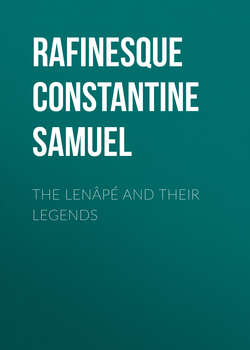The Lenâpé and their Legends

Реклама. ООО «ЛитРес», ИНН: 7719571260.
Оглавление
Rafinesque Constantine Samuel. The Lenâpé and their Legends
PREFACE
CHAPTER I
CHAPTER II. The Wapanachki or Eastern Algonkin Confederacy
CHAPTER III. The Lenape or Delawares
CHAPTER IV. The Literature And Language Of The Lenape
CHAPTER V. Historical Sketches of the Lenape
CHAPTER VI. Myths and Traditions of the Lenape
CHAPTER VII. The Walam Olum: Its Origin, Authenticity And Contents
THE WALUM OLUM or RED SCORE, of the LENÂPÉ
NOTES
VOCABULARY
APPENDIX
Отрывок из книги
About the period 1500-1600, those related tribes whom we now know by the name of Algonkins were at the height of their prosperity. They occupied the Atlantic coast from the Savannah river on the south to the strait of Belle Isle on the north. The whole of Newfoundland was in their possession; in Labrador they were neighbors to the Eskimos; their northernmost branch, the Crees, dwelt along the southern shores of Hudson Bay, and followed the streams which flow into it from the west, until they met the Chipeways, closely akin to themselves, who roamed over the water shed of Lake Superior. The Blackfeet carried a remote dialect of their tongue quite to the Rocky Mountains; while the fertile prairies of Illinois and Indiana were the homes of the Miamis. The area of Ohio and Kentucky was very thinly peopled by a few of their roving bands; but east of the Alleghanies, in the valleys of the Delaware, the Potomac and the Hudson, over the barren hills of New England and Nova Scotia, and throughout the swamps and forests of Virginia and the Carolinas, their osier cabins and palisadoed strongholds, their maize fields and workshops of stone implements, were numerously located.
It is needless for my purpose to enumerate the many small tribes which made up this great group. The more prominent were the Micmacs of Nova Scotia, the Abnakis of Maine, the Pequots and Narragansets, in New England, the Mohegans of the Hudson, the Lenape on the Delaware, the Nanticokes around Chesapeake Bay, the Pascataway on the Potomac, and the Powhatans and Shawnees further south; while between the Great Lakes and the Ohio river were the Ottawas, the Illinois, the Pottawatomies, the Kikapoos, Piankishaws, etc.
.....
The vegetable world supplied a variety of dyes in the colored juices of plants. These were mixed with the acid juice of the wild, sweet-scented crab apple (Pyrus coronaria; in Lenape, tombic'anall), to fix the dye.
A red was yielded by the root of the Sanguinaria Canadensis, still called "Indian paint root;" an orange by the root of Phytolacca decandra, the poke or pocoon; a yellow by the root of Hydrastis Canadensis; a black by a mixture of sumac and white walnut bark, etc.[90]
.....